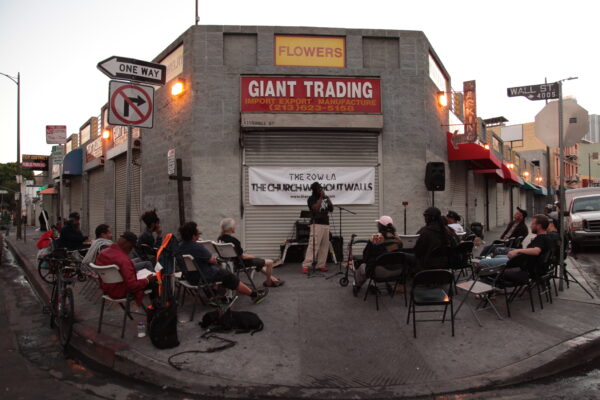This article was published by the John Templeton Foundation about CRCC’s Religious Competition & Creative Innovation project, which the Foundation funded.
In a Huntington Beach, California laundromat, volunteers wash clothes for homeless and low-income community members as part of an outreach ministry that has become a de facto church congregation. Across town in West Los Angeles, atheists gather for a monthly Sunday morning service that borrows the format — down to the guitars and projected lyrics — of a contemporary Evangelical church service. Not far from the Hollywood sign, Christian missionaries from India lead a thriving multi-ethnic congregation that eschews traditional titles like “pastor” and “church.” In Azusa, the leader of a Thai mosque contemplates how a minority within a minority can welcome and serve the broader community, while in downtown LA’s Skid Row, a church without walls welcomes homeless people to take a folding chair for a lively sidewalk service.
Meanwhile, on the other side of the Pacific, the leaders of a Korean megachurch eschew family dynasties and purpose-built church buildings to free resources to focus on the congregation’s mission.
This eclectic collection of places, stories, and scenarios are just a few of the dozens documented and analyzed researchers at the University of Southern California’s Center for Religion and Civic Culture as part of a two-and-a-half-year project studying the ways that religious groups in two major world metropolises evolve, compete and innovate.
Religion and the marketplace
According to Richard Flory, the center’s Senior Director of Research and Evaluation, the religious innovation study’s initial goal was to understand whether competition between religious groups spurs creativity in the way that it can for competitors in free-flowing economic markets. To get a better sense of the creative landscape in Los Angeles and in Seoul, Flory’s group gathered information on more than 600 congregations in the two cities and conducted 86 in-depth case studies on individual groups.
“The initial questions were framed around the sociological and economic studies of religion as rational choice, market competition kinds of models,” Flory says. “We’ve seen that really works well on a macro level, in Latin America or in certain parts of Africa. Our question was, does that really happen at the local congregational level?”
What Flory’s team found was that their initial hypothesis was more or less confirmed, but not in the way they had assumed. Rather than religious groups working to be creative and relevant in order to entice people away from other options, the researchers found numerous cases where a thriving religious marketplace was not a zero-sum game. Individual worshippers often partook from multiple religious offerings — attending a neighborhood church while also taking advantage of conferences or worship experiences available from larger congregations. The ability to receive from multiple sources helps sustain a highly segmented religious landscape, where small, focused congregations don’t necessarily have to compete directly with other offerings.
Meanwhile, larger congregations often adapt and institutionalize innovations from smaller ministries. “It’s kind of competition but it’s kind of borrowing and kind of collaborating,” Flory says. In most cases innovation was found in smaller groups, which simply have more freedom to experiment and adjust compared to larger institutions, which may have more resources but also have more organizational inertia.
Something new under the sun
Innovation has been a common element throughout the history of human religion. “Religion can’t continue to exist if it doesn’t change,” Flory notes. “It will become an artifact of history if it doesn’t adapt to the circumstances around it.” Interestingly, though, the survey uncovered some contemporary groups that embrace change to such an extent that they are unconcerned with their own preservation. The founder of the laundry-for-the-homeless service told Flory he wouldn’t be worried if the thriving church that spawned the ministry ran its course and disbanded within a few years (as, in fact, it did). Flory’s colleagues in Seoul found large congregations that were intentionally making a break from the hallmarks of a generation of Korean megachurches, including sprawling physical facilities and leadership dynasties passed down from father to son. In their place: rented worship spaces and — in at least one case — term limits for pastors and elders.
“There’s starting to be this idea that ‘it’s okay if we have a church that last for five or ten years and it goes away.’ That’s a different view from building a big cathedral that’s always going to be there,” Flory says.
Changing — but changed?
In light of these findings, Flory and his colleagues hope to do further in-depth studies of the secondary effects of religious innovation. “How do religions maintain their vitality and their relevance without giving up core parts of their tradition? If you don’t have some sort of core identity for a group, you don’t really have a reason to exist,” he asks. “In these innovative groups, how are their conceptions of God changing, and how are their religious identities changing as they innovate over time?”
Flory also wonders how the role and allure of the so-called religious “nones” will play into the religious landscape of places like LA and Seoul. While in America significant numbers still report to being “spiritual but not religious,” Flory’s colleagues in Korea found that in Seoul, barely anyone fit that category — the “nones” were neither religious nor spiritual. Flory notes that for decades the prominent theory of secularization held that as societies modernize, religious interest will decline as it has in Western Europe. But that isn’t always the case: “There’s also evidence that as societies are modernizing and being included in the global capitalist system, that provides more opportunities for religion to flourish,” he says. “You’re still finding places where religion is incredibly successful in the midst of this modernization process.”

